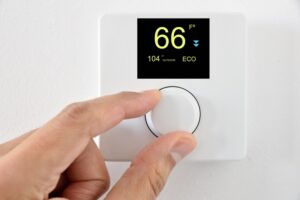What a glorious system a heat pump is. It cools your home like an air conditioner. It provides heating, and it does so incredibly efficiently. In a warm climate, it might even provide all the heat you need at an impressively low cost. And it can automatically and effortlessly switch between heating and cooling modes. How does one system manage all this? Your heat pump has a specialized component called the reversing valve. Here’s what you should know about how it works and what to do if it isn’t working.
AC Technology
The basics of air conditioning technology involve circulating refrigerant through coils. Because the refrigerant absorbs and releases a lot of heat when it changes state from a gas to a liquid or back again, it can be used to move heat from place to place. This requires that it be under a lot of pressure, so AC systems also have a compressor. Finally, there’s a fan to move the freshly cooled air once the air conditioner does its job.
The Heat Pump Bonus
Generating heat the way a furnace does is expensive. It requires a lot of energy. With a heat pump, you can avoid all that. It doesn’t generate heat more efficiently. What it does is skip the generating heat entirely; instead, it moves heat around.
Just like the air conditioner does, the heat pump circulates refrigerant under pressure to take in heat and then let it out. It might seem like there isn’t any heat outdoors that could possibly be brought in when your house needs to be warmed. But it doesn’t need to be hot outside for the heat pump to work. It just needs to be a few degrees less cold than the super-chilled refrigerant, and heat can be delivered indoors.
The Reversing Valve
In order for a heat pump to be able to operate in either direction—carrying heat out during the summer or in during the winter—it needs to be able to change the direction that the refrigerant flows through the loop of coils. This is where the reversing valve comes in. This component can open, allowing refrigerant to flow one way, or close, forcing it to flow in the opposite direction.
To do this requires pressure to be applied on a small slider. That pressure is delivered by a solenoid, which is a type of electromagnet. It can only operate when it receives an electrical charge. So, the thermostat sends a signal, it passes through electrical wires, the solenoid slides, and the heat pump switches modes.
But what if your heat pump won’t switch? The “passive” position of the slider, when the solenoid doesn’t receive a charge, is the position for heating. To switch to cooling, three things need to be working together: the signal from the thermostat, the electrical wiring, and the solenoid itself. If springtime arrives and you can’t get your heat pump to start cooling, you need heat pump service in Slidell, LA.


